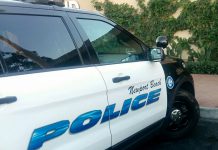
Newport Beach firefighters teamed up with other local fire crews Tuesday during a wildland fire training event in the hills of Newport Coast.
Newport Beach firefighters will respond to numerous calls for structure blazes during their career and most will be called to an out-of-county wildland fire, said retired Newport Beach Fire Department (NBFD) Capt. Jerry Strom, but a large, destructive wildfire in Newport Beach is a very real possibility.
“Newport Beach has the potential for a mutual aid fire… There are areas that have the potential of getting out of control,” Strom said. A mutual aid fire is a blaze that could or has become uncontrollable and multiple units are called in to assist.
The type of vegetation, topography, climate and strong Santa Ana winds would all contribute to a wildfire. Areas at the highest risk are Newport Coast, Corona del Mar, and Buck Gully. And it could happen at anytime, so the refresher course is an important training exercise for firefighters.
“The California fire season is 12 months a year,” said NBFD engineer Terry Teale.
Firefighters from Newport Beach Fire Department (NBFD), Laguna Beach and Costa Mesa learned about preparation, safety, organization, and techniques and participated in hands-on exercises.
The annual refresher course is required for firefighters on strike teams, the crews sent out of the county to assist other cities battling wildfires.
Firefighters participated in two exercises on Tuesday, running and extending the light-weight single-jacket hose used specifically for wildland fires and clearing an area, deploying and using the protective, portable fire shelter.
The type of hose used in a structure fire versus a wildland fire is different, said NBFD Battalion Chief Jeff Boyles. The hose used for wildfires has a smaller nozzle, is lighter and can be extended, said NBFD engineer Brent Conklin.
Each firefighter carries 200 feet of hose on their back, Conklin said, and a crew can potentially have up to 1,000 feet.
The firefighters also used orange “controlled deployment” practice shelters, made of a tarp-like plastic material on Tuesday, but the “real deal” shelters are blue and made of a thicker, foil-like material with a fire-resistant outside and a protective interior, said Laguna Beach Division Chief Dan Stefano.

The fire shelter is used as an absolute, last resort option if overrun by a wildfire, Boyles said.
“It will deflect some of the heat, but it will still be extremely hot,” Boyles said.
Firefighters first have to clear an area, being sure to create a hole for clean air for breathing, deploy their fire shelter, crawl completely inside and huddle down on the ground.
“And keep your feet to the fire,” he added.
The shelters work pretty well, although elsewhere there have been deaths and injuries reported while using them, they should be used as a last resort, Boyles said. Always try to get out of the path of the fire first, he said, safety is most important.
“Don’t put yourself in harms way,” Stefano said.
Reference guides, detailed maps, guides about fuel and moisture patterns, books and other informational resources were available for the firefighters to read through.
That kind of pre-planned information wasn’t available for the big 1993 Laguna firestorm, which both Teale and Strom battled.
The Laguna fire destroyed over 350 homes, damaged over 500 more homes, burned over 16,000 acres of brush land and caused $528 million in damage.
“That fire burned really fast,” Strom said. Some areas burned all the way to the ocean, he added.
The fire started near Laguna Canyon Road and eventually burned its way into Crystal Cove State Park, almost through Corona del Mar and stopped just before Newport Coast Drive. Tuesday’s training was in the same area that the fire burned less than two decades earlier.
“We were really concerned about it getting to Buck Gully,” Strom said.
It was fueled by strong winds, rough terrain and dry, thin vegetation, called flash fuel. This type of vegetation burns up very quickly and feeds the fire, helping it move along quickly.
Flash fuel also helps heat up other vegetation that normally would take longer to burn because they’re thicker, denser or have a higher moisture content, called heavy fuel. But the flash fuel plants help create such a hot fire that the heavy fuel vegetation gets dried out and becomes highly flammable.
“With this kind of fire, you really have to be on your toes,” Teale said, especially since the wind can shift and the weather can change at any moment.
A fire this big can sometimes create its own “microclimate,” Teale said, like generating its own wind, which can make things even tougher.
Mother nature can work for or against the firefighters, Teale said. In this particular blaze, the wind is also what helped extinguish it.
Just as the blaze was about to reach Newport Coast Drive, the winds changed abruptly, swirled around and over the ocean and brought in the moisture from the sea, forcing the fire toward Irvine and increasing the humidity in the air.

Fighting a wildland fire is quite a bit different than a structure fire, Teale and Strom agreed.
A major difference between wildfires and structure fires is the time spent on scene, fighting the blaze, both Teale and Strom agreed. A firefighter can be out fighting for hours upon hours, Teale said.
“It’s important to be fit, hydrated and ready,” Teale said.
It can sometimes take a while to get to the fire to, depending if it’s in or out of the county. And it also takes longer to get to the base camp, the staging area (where firefighters are organized, briefed and sent out) and out to the actual fire.
“You do it until you get it accomplished,” Teale said.
A structure fire on the other hand, can take just minutes to get to, minutes to hours (depending on the intensity and size of the home) to fight and firefighters are going the moment their feet hit the ground.
“Firefighters may have to respond to fires throughout California. We don’t have enough firefighters on duty on a daily basis to successfully fight a major wildland fire in Newport Beach, so we would rely on our neighboring communities to assist us,” said NBFD spokeswoman Jennifer Schulz. “(Tuesday’s event) allows our firefighters to gain invaluable practical firefighting skills… To be ready to respond within our city or on a strike team.”
There is a lot people can do to help prevent fire from reaching their home, Teale said, and questions can be answered by calling the local fire department.
Tips can be found on the fire department’s website at www.newportbeachca.gov/fire.
The decisions the fire crew leaders make and how the fire is fought makes all the difference, Teale said.
“You can’t outrun a fire,” Teale said. “There are winners and losers, and you have to figure out what (battles) you can win… You have to fight smart.”
See more photos from the event here.





